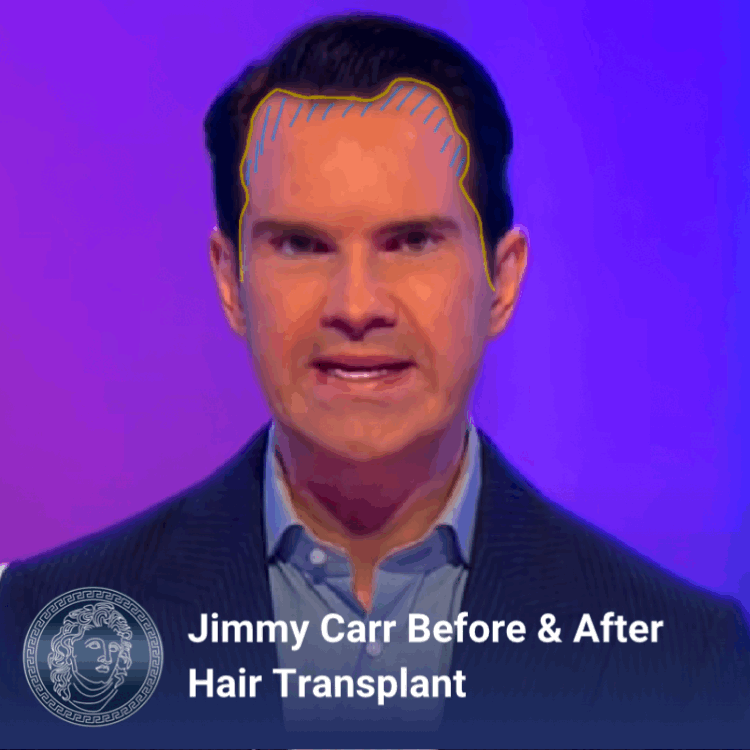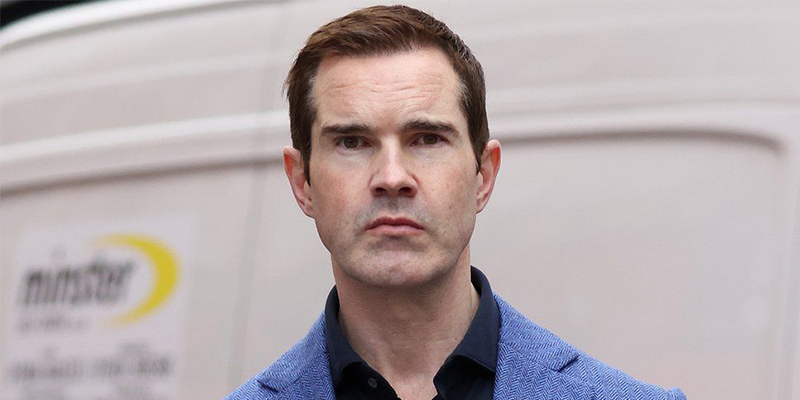Jimmy Carr, the well-known British comedian and television host, has been remarkably open about his hair transplant journey. Unlike many celebrities who keep their cosmetic procedures private, Carr publicly discussed getting a hair transplant as part of his mid-life transformation after becoming a father. His candid approach to discussing the procedure has helped normalize conversations about male hair restoration.
Key points about Jimmy Carr’s hair transplant:
- Jimmy Carr got a hair transplant to restore temple and hairline recession
- Carr got FUE (Follicular Unit Extraction) hair transplant
- Received approximately 4000 individual hair follicles
- The procedure lasted 14 hours
- Combined with other aesthetic improvements, including dental work and Botox
- Maintains excellent results after 4 years
Who is Jimmy Carr?
Jimmy Carr is a prominent British comedian and television presenter who has dominated UK entertainment since the early 2000s. Best known for hosting popular panel shows including “8 Out of 10 Cats” and “8 Out of 10 Cats Does Countdown,” Carr has become a fixture of British television. His sharp wit and distinctive laugh have made him one of Britain’s most recognizable comedic personalities.
What was Jimmy Carr’s early career like?
Jimmy Carr’s early career began in the corporate world. After feeling unfulfilled in corporate marketing, Carr took a leap of faith and performed his first unpaid stand-up set at the Tut ‘n’ Shive pub in Islington in December 1999. His career gained momentum after his successful 2001 Edinburgh Fringe show, Rubbernecker, which he performed alongside Ricky Gervais, Stephen Merchant, and Robin Ince.
How did Jimmy Carr’s hair look during their early years?
Jimmy Carr’s hair during his early career showed signs of the classic male pattern baldness progression. Even in the first season of “8 Out of 10 Cats,” his hairline was visibly receding. Despite the recession, his hair maintained good density and displayed a dark, voluminous, and shiny appearance.
When did Jimmy Carr start losing his hair?
Jimmy Carr’s hair loss became noticeable during the early seasons of “8 Out of 10 Cats,” and the progressive recession continued throughout his career.
How did Jimmy Carr’s hair change over time?
Jimmy Carr’s hair transformation occurred gradually over his years in the spotlight. His initial appearance featured a notable widow’s peak, which he himself described as having a ‘snooker-playing vampire’ appearance. The recession primarily affected his temples and hairline, creating an increasingly pronounced M-shaped pattern that became more apparent as the years passed.

What is the reason for Jimmy Carr’s hair loss?
Jimmy Carr’s hair loss pattern strongly suggests androgenetic alopecia, commonly known as male pattern baldness. This condition typically affects the hairline and temple areas first, creating the distinctive recession pattern visible in Carr’s earlier appearances.
How did hair loss affect Jimmy Carr’s confidence?
Jimmy Carr openly shared that the procedure was part of a broader “mid-life crisis” transformation after becoming a father. His desire was to present himself on screen as he felt in real life, leading to multiple cosmetic improvements, including a hair transplant, Botox, dental work, and weight loss.
What sparked rumors about Jimmy Carr’s hair transplant?
James Carr did not allow rumors to circulate about his hair and openly debuted his hair transplant results during his show.
Did Jimmy Carr have a hair transplant?
Yes, Jimmy Carr had a hair transplant and has been refreshingly candid about the procedure. He has publicly praised the importance of being open about such treatments, noting that many Hollywood actors unnecessarily deny having similar procedures done, even though everyone can tell.
Which type of hair transplant did Jimmy Carr get?
Jimmy Carr underwent an FUE (Follicular Unit Extraction) hair transplant. The FUE technique involves individually extracting hair follicles from the donor area and implanting them into the little incisions made in recipient sites.
How many grafts did Jimmy Carr get transplanted?
Jimmy Carr’s procedure involved approximately 4000 individual hair follicles, likely translating to 1500-1800 actual grafts.
While Carr himself mentioned receiving 4000 grafts, this number likely refers to the total hair follicles rather than the graft count, as each graft can contain multiple hair follicles. Given the extent of his hair loss and the results, it’s highly unlikely that Carr received 4000 grafts, and 4000 individual follicles seems more likely.
Where did Jimmy Carr get his hair transplant?
Jimmy Carr received his hair transplant in the UK, but the clinic’s name remains undisclosed.
What details are known about Jimmy Carr’s hair transplant?
Jimmy Carr’s hair transplant procedure lasted 14 hours, during which he watched Netflix and listened to the radio. He described the experience as “uncomfortable” rather than painful. Carr’s hair transplant was part of a larger transformation that included dental work and Botox treatments.
Does Jimmy Carr use any supplementary hair loss treatments?
Jimmy Carr did not publicly share about any supplementary treatments he might use to maintain his hair transplant results.
How much did Jimmy Carr’s hair transplant cost?
Jimmy Carr’s hair transplant cost remains undisclosed, but given his celebrity status and the typical pricing at premium UK clinics catering to high-profile clients, the procedure likely cost between £20,000 and £30,000.
How does Jimmy Carr look after his hair transplant?
Jimmy Carr’s hairline appears straighter and more defined, with filled-in temples that create a more balanced facial frame and a smaller-appearing forehead. It’s safe to say that he no longer looks like a snooker playing vampire.

How has Jimmy Carr’s hair transplant held up over time?
After four years, Jimmy Carr’s hair transplant shows excellent results. His hairline maintains its straightness, but the temple areas are slightly open, demonstrating the procedure’s long-term natural results.
How has Jimmy Carr styled his hair after hair transplant?
Following his transplant, Jimmy Carr has opted for a slightly shorter hairstyle compared to his previous days. He appears to maintain the color through regular dying, keeping his signature dark appearance.
What does Dr. Ömer Aykut Sümer of MedArt Hair think of Jimmy Carr’s alleged hair transplant?
Dr. Sümer notes that Jimmy Carr’s transplant required minimal retouching and achieved natural-looking results. He suggests that the reported 4000 grafts likely refer to individual hair follicles rather than complete grafts, estimating the actual graft count at 1500-1800.
Why Do Many celebrities get hair transplants?
Celebrities often pursue hair transplants to maintain their public image and boost their confidence in an industry where appearance plays a crucial role. The entertainment sector’s high-definition cameras and constant scrutiny make hair loss particularly noticeable, leading many performers to seek restoration procedures.
Which other celebrities had a hair transplant?
Other notable celebrities who have undergone hair transplants include:
- Wayne Rooney
- Lewis Hamilton
- Rob Brydon
- James Nesbitt
- Joe Swash
References:
https://www.mirror.co.uk/3am/celebrity-news/jimmy-carr-opens-up-hollywood-25185376

